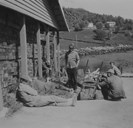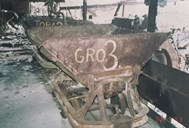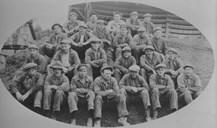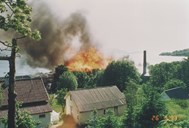Market for brick
At Helle and at Vårdal there was an abundance of clay, which formed the basis for the production of brick. Johan Jenssen from Bergen, living at Holmedal, took the initiative to establish Helle Teglverk A/S in 1895. At the time there was a building boom in the towns, and in Bergen brick was in strong demand. In many places new brickyards were put into operation.
In business until 1978
But after 1900 the demand for brick from Helle fell, and the sales failed. In 1907, the brickyards went bankrupt. After this the former manager of Vårdal Teglverk, Jørgen Helgerud, took over the works at Helle. The production was modernised, which meant mechanised shaping of the bricks, installation of crushing rolls, a chain excavator, and the introduction of electric power.
After 1907, Jørgen Helgerud was among the new shareholders in the brickyard. With time, the Helgerud family became sole owners. They also bought up 50% of the shares in Vårdal Teglverk, and the rest in 1968. The demand for brick improved. Helle Teglverk was in business every year until it was closed down.
Competition and shortage of raw material
During the reconstruction of the country after the Second World War, many building materials were rationed. For brick this was the case until 1957. Brick met competition from other building materials, such as concrete stone, Siporex, and Leca. These products quickly took over the market which brick had dominated.
The clay at Helle is coarse and contains much sand. This caused wear and tear on the machines. Because of the low quality of the clay, brick from Vårdal and Helle was used mainly for backing walls.
Jobs and organised labour
The brickyards in the Dalsfjord area provided much needed jobs in the small communities, 35-40 jobs at each. Many combined work there with farming. During recessions, when the storage rooms were full, it was good to have more than one string to one's bow. After the war, the works were modernised, and in the 1950s, 65-70 men were employed at the two brickyards.
In the 1920s, the demand for brick was weak, and lay-offs were frequent. Several were unemployed for periods. Yet the organised labour movement came late to the Dalsfjord area, where most of the workers had their backgrounds on smallholdings, and often had smallholdings of their own. Only in the 1930s, the Vårdal Arbeidarforeining (trade union) was founded.
Trade union
Helle Arbeidarforeining was founded in 1936, and the pay issue seems to have been the main driving force behind the organisation. The brick workers at the same time took membership in the Bygningsarbeidarforbundet (builders' trade union). And the working conditions soon improved. But their relations with the management of the brickyard were tense at times, and active members of the trade union were sacked. The unions at Vårdal and at Helle were merged in 1974, and in 1988, the remaining members took membership in the local union of the Fellesforbundet (nationwide trade union).
Liquidation
In the 1960s, the demand for brick was weak, 1976 was the last year of production at Helle Teglverk, and the operation was permanently closed down in 1978. After this it was decided to restore and preserve the facilities, but in 1993 the building burnt down.





